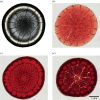Pattern formation in drying blood drops
- PMID: 34148412
- PMCID: PMC8405133
- DOI: 10.1098/rsta.2020.0391
Pattern formation in drying blood drops
Abstract
Patterns in dried droplets are commonly observed as rings left after spills of dirty water or coffee have evaporated. Patterns are also seen in dried blood droplets and the patterns have been shown to differ from patients afflicted with different medical conditions. This has been proposed as the basis for a new generation of low-cost blood diagnostics. Before these diagnostics can be widely used, the underlying mechanisms leading to pattern formation in these systems must be understood. We analyse the height profile and appearance of dispersions prepared with red blood cells (RBCs) from healthy donors. The red cell concentrations and diluent were varied and compared with simple polystyrene particle systems to identify the dominant mechanistic variables. Typically, a high concentration of non-volatile components suppresses ring formation. However, RBC suspensions display a greater volume of edge deposition when the red cell concentration is higher. This discrepancy is caused by the consolidation front halting during drying for most blood suspensions. This prevents the standard horizontal drying mechanism and leads to two clearly defined regions in final crack patterns and height profile. This article is part of a discussion meeting issue 'A cracking approach to inventing new tough materials: fracture stranger than friction'.
Keywords: blood; coffee ring; diagnostics; droplet drying; drying.
Figures







References
-
- Kulyabina TV, Drajevsky RA, Kochubey VI, Zimnyakov DA. 2001. Coherent optical analysis of crystal- like patterns induced by human blood plasma desiccation. Saratov Fall Meeting 2000: Coherent Optics of Ordered and Random Media. Vol. 4242, pp. 282–285.
-
- Rapis E. 2002. A change in the physical state of a nonequilibrium blood plasma protein film in patients with carcinoma. Tech. Phys. 47, 510–512. (10.1134/1.1470608) - DOI
-
- Brutin D, Sobac B, Loquet B, Sampol J. 2011. Pattern formation in drying drops of blood. J. Fluid Mech. 667, 85–95. (10.1017/S0022112010005070) - DOI
MeSH terms
Substances
LinkOut - more resources
Full Text Sources
